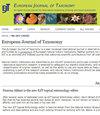An assessment of new character in hoverfly species delimitation using linear and geometric morphometrics – genus Merodon Meigen, 1803 (Diptera: Syrphidae) as a case study
IF 1.3
3区 生物学
Q3 ENTOMOLOGY
引用次数: 0
Abstract
Detection of morphologically indistinguishable cryptic species implies using an integrative taxonomic approach with a combination of molecular, contemporary morphological, ecological and other relevant analyses. Within a contemporary morphological analysis, two approaches are commonly used in hoverfly taxonomy: a geometric morphometric analysis of the wing and surstyle shape. Here, the importance of the R4+5 vein shape is tested in cryptic species delimitation within four Merodon species groups using linear and semilandmark geometric morphometric analyses. As expected, geometric morphometrics showed a stronger resolution compared to linear morphometrics. Linear morphometrics failed to detect differences related to sexual dimorphism or differences among the species M. pruni and M. obscurus. However, all cryptic species and sexes were separated with high significance based on the R4+5 vein shape. Moreover, obtained results concurred with the landmark-defined wing shape and molecular results published in previous studies. Additionally, combining two characters, the semilandmark R4+5 vein shape and the landmark-defined wing shape, provided more detailed and precise insights into the shape differences. Our results showed that the R4+5 vein shape stands out as an important character in species delimitation of hoverflies where the sinuation of this vein is present. Therefore, it can be beneficial as a single character or in combination with a landmark-based wing shape analysis.利用线性和几何形态计量学评估食蚜蝇物种划分中的新特征 - 以 Merodon Meigen, 1803 属(双翅目:蚜科)为例进行研究
对形态上难以区分的隐种的检测意味着采用分子、当代形态、生态和其他相关分析相结合的综合分类方法。在当代形态学分析中,两种方法通常用于食蚜蝇分类:翅膀和体表形状的几何形态分析。本文利用线性和半里程碑几何形态计量学分析,在四个Merodon种群的隐种划分中测试了R4+5脉形状的重要性。正如预期的那样,几何形态计量学比线性形态计量学显示出更强的分辨率。线性形态计量学未能检测到与雌雄二态性相关的差异,也未能检测到褐毛鼠和暗毛鼠之间的差异。然而,根据R4+5脉形,所有隐种和性别都有高度显著性分离。此外,所获得的结果与先前研究中发表的具有里程碑意义的翼形和分子结果一致。此外,结合两个特征,半标志性的R4+5脉形状和标志性的定义翼形状,提供了更详细和精确的形状差异的见解。结果表明,R4+5静脉形态是食蚜蝇物种划分的重要特征。因此,它可以是有益的作为一个单一的字符或结合基于地标的翼形分析。
本文章由计算机程序翻译,如有差异,请以英文原文为准。
求助全文
约1分钟内获得全文
求助全文
来源期刊

European journal of taxonomy
ZOOLOGY-
CiteScore
2.30
自引率
8.30%
发文量
173
审稿时长
29 weeks
期刊介绍:
EJT is a fully refereed, international, fully electronic Open Access journal in descriptive taxonomy, covering subjects in zoology, entomology, botany (in its broadest sense), and palaeontology. EJT-papers must be original and adhere to high scientific (content) and technical (language, artwork, etc.) standards. Manuscripts that are clearly substandard in either of these categories will not be sent out for review. EJT is supported by a consortium of European Natural History Institutes, but its scope is global. Both authorship and geographical region of study need not be European. Authors are, however, strongly encouraged to involve European Natural History collections by consulting material or by depositing specimens (e.g. types and figured material) related to their published paper in the collection of a European Natural History Institute.
 求助内容:
求助内容: 应助结果提醒方式:
应助结果提醒方式:


